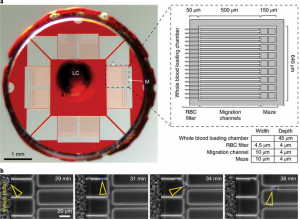 Fascinating new research by Felix Ellett and co-authors from Massachusetts General Hospital (MGH) and Harvard Medical School (HMS) shows elegant detection of sepsis in hospital patients via microfluidic blood analysis. The study was published recently in Nature – Biomedical Engineering and profiled by MGH and Technology Networks.
Fascinating new research by Felix Ellett and co-authors from Massachusetts General Hospital (MGH) and Harvard Medical School (HMS) shows elegant detection of sepsis in hospital patients via microfluidic blood analysis. The study was published recently in Nature – Biomedical Engineering and profiled by MGH and Technology Networks.
Previous research from Daniel Irimia‘s group at MGH and HMS in 2014 showed that dysfunctional behaviour of neutrophils (a type of white blood cell) correlated well with sepsis. This current research from his and Jarone Lee‘s (MGH) groups takes the next step and uses a microfluidic device to perform the analysis. Their 5-mm device has 4.5-µm channel filtres (to screen out red blood cells) and meandering channel networks to allow the neutrophils to leave the sample drop of blood, and be observed in the microfluidic channel network. Discrimination by neutrophil characteristics & behaviours (such as number of neutrophils, oscillations and motionless time in microfluidic channels, migration distance and tendency to migrate back to the central sample chamber) allowed the researchers to correctly predict the presence of sepsis in over 95% of patients in a small study of 19 ICU patients.
Detection of sepsis in patients is of critical importance. According to the MGH and TN article profiles, about one million cases of sepsis occur annually in the US, with 25% of cases being fatal. Comparable data from the UK showed that the mortality rate for hospital admissions with severe sepsis assessed withing the first 24 hours was 45%. Current detection methods leave much to be desired, with misdiagnosis occurring in 30% of patients. The arrival of fast, accurate diagnostic methods would lead to better patient outcomes, likely including saved lives.
